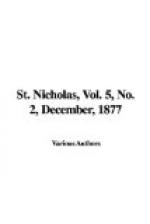“In life, no one, my dear; but there are many things in Chinese art that are not much like living objects.”
[Illustration: DRESDEN CHINA.]
“I suppose you have all heard of Dresden china,” presently continued her uncle.
“Oh yes, sir!” cried Al. “Aunt Susie had a Dresden tea-pot that belonged to her grandmother, and she said the tea always tasted better out of it than from anything else.”
“Well, here is an excellent French copy of an old Dresden figure. It is a pretty flower-girl. See how gracefully she reaches for a nosegay from her basket. I have seen bouquets of Dresden porcelain that you could hardly distinguish from real flowers,” said Uncle Jack.
“You’d hardly think that such a beautiful thing was made from common earth,” said Will.
“Nor is it,” said his uncle. “This kind of china is made from a very fine and very rare clay that, for a long time, was found only in China and the Corean islands; but about a hundred and sixty years ago, a noted chemist of Meissen, in Saxony, named Boettcher, discovered a bed of it there, and manufactured the first true porcelain made in Europe,” said Uncle Jack.
[Illustration: TERRA COTTA VASE.]
“Why couldn’t they get the fine clay from China and make their porcelain anywhere?” asked Will.
“Because the Chinese jealously kept all their clay to themselves,” answered Uncle Jack.
“How did that man come to discover where the clay was, and if it was of the right kind?” asked Al.
“By a strange chance. According to the fashion of the time, men powdered their hair, using wheat flour for that purpose. One day a neighbor of the chemist, in traveling an unfrequented part of the country, observed on his horse’s hoofs some white sticky clay, and it occurred to him that this white clay, dried and powdered, would make an excellent and cheap substitute for wheat flour as a hair powder. So he carried a little home with him, and some of it finally reached Boettcher. The chemist found it extremely heavy, and, fearing the presence of some metal hurtful to the skin, he tested the clay in his laboratory. To his surprise and joy this white hair-powder proved itself possessed of the same qualities as the veritable Chinese kaolin, as their clay is called.”
[Illustration: MARK OF DRESDEN CHINA.]
[Illustration: MARK OF WORCESTER PORCELAIN.]
“Why, that sounds like a story,” said Matie.
“Here now,” said Uncle Jack, “is a vase; that might carry the mind back thousands of years, to the time when bodies were burned instead of buried, and the ashes kept in just such urns as this.”
“Is that vase thousands of years old?” asked Matie.
“No, dear; this vase is only modeled after the ancient cinerary urns, as they were called, and was made a year or two ago by Ipsen, of Copenhagen.”
“That isn’t porcelain, is it, uncle?” asked Al.




